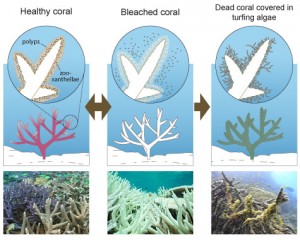Over the past week, the idea that the Great Barrier Reef has “died” has been circulating around the media. Rowan Jacobsen of Outside Magazine wrote an article on October 11th in the form of an obituary for the Great Barrier Reef, that sparked this media frenzy. Although, this is actually false as the reef is still alive in some areas, but regardless it is still in grave danger.
For several years the Great Barrier Reef has been subject to bleaching, which is the process that occurs when temperatures of the surrounding waters rise above, or fall below their averages and cause the symbiotic algae living inside of the coral to discharge from the corals tissue. This causes the coral to lose color and turn very pale or white, hence why the process is called bleaching. Bleaching does not kill the coral, rather it leaves the marine invertebrates very feeble and vulnerable to disease, which can lead to the corals eventual death. Other confounding variables play into coral bleaching as well such as low salinity or pollution that runs-off into the ocean
In the Great Barrier Reef’s case, there have been several incidents in which mass coral bleaching has devastated the area. Around 50% of the reefs within the Great Barrier Reef were bleached in 1998 when the waters around the reef were the highest ever recorded. 5% of the coral that was bleached was damaged beyond return. Another mass bleaching occurred in 2002, this time leaving 60% of the reefs bleached and once again rendering 5% of the coral damaged permanently. According to the reefs 2014 Outlook Report, the percent of hard coral covering has shrunken from to 28% in 1986 when the reef was first officially being monitored, down to 13.8% in 2014. The reef is also not home to just coral, but is also a home for thousands of species and a complex ecosystem that has taken a toll from the destruction of the reef. For example, as shown on the biodiversity page of the outlook, the sea grass abundance score has declined from a score of 60 in 2002, to a score of around 25 in 2013. In turn this has caused a decline in the population of a certain species of manatee called the dugong, as well as other species who depend on the meadows for nutrition/protection.
So the reef is not completely dead contrary to popular belief, but the question that remains is can the reef ever return to a healthy state?
Currently according to the National Oceanic and Atmospheric Administration’s, “A Reef Managers Guide to Coral Bleaching” coral reefs are experiencing the highest water temperatures in over 400,000 years. Global sea temperatures are predicted to rise by 1.4-5.8 degrees Celsius by the year 2100. This in turn would create more coral bleaching epidemics as these temperatures would cause the symbiotic algae to dislodge from the coral even after an increase of a s little as .6 of a degree Celsius. So, with rising temperatures evident in the near future, can the coral adapt?
The current hypothesis is the coral has the potential to adapt to rising temperatures and resist the bleaching effect. For example the same species of coral could have different thresholds of bleaching. According to the coral bleaching guide, one species of coral has a threshold of 28 degrees Celsius in the Galapagos, but can withstand temperatures of up to 34 degrees Celsius in the Persian Gulf without bleaching. This shows that coral has the ability to create variability and adapt to different environments over time. But its really a question of how fast the coral can adapt.
Like many other species, natural selection takes place and allows the coral with the most successful genotype to survive and create a new generation of coral with this genotype. In this case, that genotype would be resistance to temperature, in order to allow the coral to have a higher bleaching threshold. Coral has a special ability called acclimatisation, in which the coral can make biochemical changes at the cellular level which allows them to withstand higher temperatures (112). This process usually takes place over several generations of coral so the only way this could save the coral is if it can adapt faster than sea temperatures rise. Its all a race against the clock to save the reef.



This blog topic really caught my eye because something like the Great Barrier reef is so spectacular and special to me. I love the ocean and if I ever went into any field of science it would be marine biology . An issue like this is really troublesome to me. Although, I wasn’t as aware of the current state of this incredible landmark and it really makes me upset. If you’re passionate enough about this issue here is a great foundation through Australia’s WWF (World Wide Fund for Nature). It gives you great insight including news, contact information, all the risks that the reef is dealing with, etc. They also give options with tabs on the home page to sign up, donate, or take action. They provide a great opportunity to take as much or as little initiative as you want to save the reef if that’s something that interests you. Back to your blog, you do list confounding variables to the reef’s declination, although, you should list them as confounding variables. These could be the bleaching, the seaweed depopulation, what causes them, etc. Use the terms we learned in class such as the possible hypotheses and conclusions. These could be is the reef in danger from a total wipeout? Is there room to recover? Your research is very informative, but along with what I just stated, try to relate it back to class topics and vocabulary.
Thanks for the feedback, I will definitely go through and add some more vocabulary.